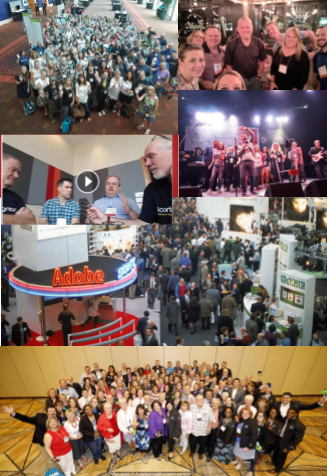Why Is #ISTESoWhite? Thoughts On Diversity #ISTE17

The International Society for Technology in Education (ISTE) conference provides a great platform to learn and connect with fellow educators. However, like other ed tech conferences, most of the attendees I encountered were not reflective of the public school students, educators like me, serve. Several colleagues and I were struck by the lack of diversity we encountered among the adults who serve our students who were in attendance.
It was particularly noticeable because of ISTE’s focus on being an International conference. As such it would stand to reason that those we saw at the conference would emphasize diversity and be representative of communities educators are serving, at least on a national level.
But, that is not what I experienced.
Some of what I experienced or noticed at ISTE.

It is worthwhile to call attention to the fact that I don't attend conferences the same way many people do. I spend most of my time in the conference halls, cafes (i.e. Blogger), meeting with folks at local establishments. I've been doing this for several years now. I started this practice when I realized the benefits that take place when instead of rushing off to "sessions," you slow down and make "connections" with people who have interesting ideas and perspectives that you'd like to explore further. So, while I was able to find and connect with people from diverse backgrounds who I sought out, I felt their lack of presence. In its place, a sea of white filled the conference floor, hallways, and hangout spaces. This really hit me when I looked at some of what was captured from the pre-conference, blogger cafe (in this pic and this vid), awards ceremony, and conference floor.
Bronx school Principal Jamaal Bowman speculates that this could be due to a few reasons. One is the fact that often people don't know about these events. He points out that chances are these communities have more pressing issues to think about, like racism. Yet, we (white people) need their voices and insights.
Jamaal thinks another problem is that white people and people of color (POC) generally don’t grow up around one another. So many of the white people that have historically attended and put these events together don't have friends from diverse backgrounds and don't know how to approach them. They also may not notice when spaces are predominantly white.
Tools and ideas to transform education. Sign up below.
A tale of two conferences
It is however, important to note, that this is my experience from the perspective of a white woman attending ISTE. Many attendees of color, had a very different story to tell. They felt supported this year. They worked together to summit proposals to present. They formed meetups. They felt there were more opportunities where they were welcomed. They came together and felt a strong sense of purpose and hope. These are tremendous accomplishments that are the result of continued work over the years to provide more adequate representation of diverse populations at ISTE and other conferences.
Part of what led to my very different experience, is that these groups, in many cases, were not interacting. We were not inviting one another into our spaces. If you look at the panel line up or presentations with multiple presenters, you will see that for the most part, they are not diverse (unless that was the topic). Yes, there are exceptions, but we need more than exceptions and we need to take notice and discuss when that is not the case.
My colleague, and #NYCSchoolsTech educator Clemencia Acevedo points out, that while the story I experienced is different from the stories of others, writing about and discussing such topics opens the door for constructive conversations, feedback, and enables us to learn with and from one another. In fact, my initial Tweet about the issue, already exposed educators such as Clemencia and myself to spaces and opportunities that are out there, but not known to many of us.
Such exposure to opportunities and conversation are necessary and ISTE is aware. In fact the issue of diversity is one ISTE’s new board president, Dr. Mila Fuller is addressing head on. New board members (Gary Brantley, and S. Dallas Dance) are people of color who are also putting this issue at the forefront. Sarah Thomas, founder of EduMatch and co-founder EdSpeakers, is another woman of color, standing out this year. She won the Making IT Happen award and had the opportunity to share her voice and insights during an ignite talk prior to the opening ISTE keynote.
ISTE is intentionally working to make progress in this area. Organizers gained momentum in attracting more people of color as participants and presenters this year. There was great progress and communities of color indeed felt more welcome than in ISTEs of the past. However, as previously noted, it seems that circles often did not intersect.
Change doesn’t happen overnight. Perhaps there is a continuum, and ensuring a more diverse representation is what precedes ensuring that we learn among one another. Sure, there were attendees who knew where to go to find an different experience that was different than mine. That is fantastic, but is unknown to many. Rather than some people have a more diverse experience at conferences like ISTE, we can be intentional in ensuring experiences where attendees can connect with a diverse group are more prevalent. This means we are focusing not only on ensuring a diverse audience present, but that we also make opportunities and safe spaces to connect and interact with, rather than separate from,one another.
I reached out to several ISTE board members and advocates and discovered some of the actions they are taking to help ensure ISTE works to serve its diverse national and international audience. Here are some of the actions they are taking.
Actions taken by ISTE organizers and advocates to invite diversity
1) Digital Equity PLN (@DigEquityPLN)
ISTE DE PLN works to inspire thoughtful discussion & action aimed to ensure access & opportunities for all. Learn more at http://bit.ly/ISTEDEpln
2) New President, ISTE Board of Directors, Dr. Mila Fuller
This is an area of focus for new board President Mila Fuller. She is working to ensure that ISTE in-person attendees represent the diverse community that is active in technology in education online and in their own communities that are influenced by ISTE.
3) Black Techs of Color Meetup
This is a private social media space where Black techs of color plan and connect. They created their own safe spaces while encouraging each other as presenters and leaders. They felt this was a good year.
5) Support from The #ISTEBoard
The ISTE Board believes in the need for an inclusive network and they are taking actions to move in that direction. They acknowledge the issue and are addressing this by ensuring their marketing materials, presenters, language used, and student standards (such as #7 Global Collaborator) are more inclusive.
What do you think? What has your experience been as an attendee of ISTE and other conferences? Does any of this resonate with you? What are some actions we can take to invite diversity? Please share in the comments and I will include in an upcoming post on the topic.
__________________________________
Editors note: Brava for making it to the end of this post. Were you looking for the strategies to invite diversity and see they are now gone? That is because due to the length of this post (1000+ words), per recommendation of blog readers, the strategies to invite diversity are being moved to a separate post which you can access here.
Lisa Nielsen writes for and speaks to audiences across the globe about learning innovatively and is frequently covered by local and national media for her views on “Passion (not data) Driven Learning,” "Thinking Outside the Ban" to harness the power of technology for learning, and using the power of social media to provide a voice to educators and students. Ms. Nielsen has worked for more than a decade in various capacities to support learning in real and innovative ways that will prepare students for success. In addition to her award-winning blog, The Innovative Educator, Ms. Nielsen’s writing is featured in places such as Huffington Post, Tech & Learning, ISTE Connects, ASCD Wholechild, MindShift, Leading & Learning, The Unplugged Mom, and is the author the book Teaching Generation Text.
Disclaimer: The information shared here is strictly that of the author and does not reflect the opinions or endorsement of her employer.
Lisa Nielsen (@InnovativeEdu) has worked as a public-school educator and administrator since 1997. She is a prolific writer best known for her award-winning blog, The Innovative Educator. Nielsen is the author of several books and her writing has been featured in media outlets such as The New York Times, The Wall Street Journal, and Tech & Learning.
Disclaimer: The information shared here is strictly that of the author and does not reflect the opinions or endorsement of her employer.
